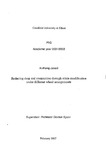JavaScript is disabled for your browser. Some features of this site may not work without it.
| dc.contributor.advisor | Spoor, Gordon | |
| dc.contributor.author | Javadi, Arzhang | |
| dc.date.accessioned | 2010-02-26T16:29:32Z | |
| dc.date.available | 2010-02-26T16:29:32Z | |
| dc.date.issued | 2002-02 | |
| dc.identifier.uri | http://hdl.handle.net/1826/4280 | |
| dc.description.abstract | New mechanisation methods associated with increasing loads have the potential to cause undesirable deep compaction, which is difficult, expensive and in some cases impossible to alleviate. Avoiding or reducing the risk of deep compaction seems to be the most straightforward solution to compaction management. Previous research indicates that some benefits can be achieved through interactions between cultivation tines or other implements, in terms of the magnitude of forces and the extent of soil deformation. Interaction within wheel arrangements could have benefits for reducing deep soil compaction. This study aimed to reduce the risk of deep soil deformation by locally modifying soil conditions through interactions in order to increase soil resistance and hence load support in the surface layers. To test the hypothesis, the research was based on soil mechanics theories and failure mechanisms related to bearing capacity in order to identify the major factors influencing load support and soil displacement. The nature of soil failure patterns, interaction behaviour, soil deformation and load/sinkage relationships were investigated under a wide range of dual and triple spaced footings/wheels configurations. Small-scale tests using rectangular plates were firstly conducted in a glass-sided tank. These initial tests were followed by larger-scale tests in a soil bin and in the field under different soil conditions using actual wheels, spaced and positioned as in the footing tests. The results indicate that it is possible to reduce soil displacement at depth by increasing load support in the soil surface layers through the interaction between spaced wheel arrangements. It was shown that different interaction modes occurred under dual configurations depending on the spacing between them. A locally compacted zone was created between the wheels under dense interaction conditions, increasing surface support. Surface support was increased further through a surcharging effect achieved by placing a third footing/wheel between and higher than the side wheels (triple arrangement). The central static interaction zone maximised the surface resistance locally under these configurations. Although single wide section wheels such as Terra tyres can tolerate higher loads at lower pressures, from a soil failure point of view, this is usually associated with large active and passive failure zones inducing deeper soil deformation. Triple spaced wheel arrangements with similar diameter wheels kept soil displacements shallower whilst carrying a similar load to a single very wide wheel with the same overall contact pressure. Reductions of up to 50% in the depth of soil displacement were achieved with the triple arrangements for the same load. These spaced arrangements can therefore be recommended as promising replacement for single wide wheel under heavy machinery application in practical situations. Benefits from the spaced arrangements are achieved in two ways: firstly by increasing surface support through creating locally compacted zones and secondly by reducing the size of active and passive failure zones causing shallower deformations. Stony soils provide more surface support than stoneless soils and also non-uniform soil with a denser layer at tillage depth can tolerate a greater load for a given sinkage compared with uniform homogenous soil. A mathematical model was developed to predict the vertical force under interacting shallow footings and showed an acceptable level of agreement with the experimental results. The model can be used to estimate the extent of the rupture distance of the side passive planes to assist in identifying appropriate spacings and interaction modes for spaced wheel arrangements. | en_UK |
| dc.language.iso | en | en_UK |
| dc.publisher | Cranfield University | en_UK |
| dc.title | Reducing deep soil compaction through strain modification under different wheel arrangements | en_UK |
| dc.type | Thesis or dissertation | en_UK |
| dc.type.qualificationlevel | Doctoral | en_UK |
| dc.type.qualificationname | PhD | en_UK |
